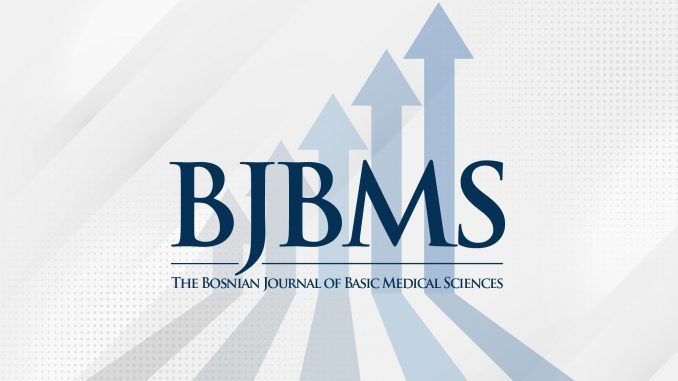
New Impact Factor (2021)
BJBMS’s Editorial team proudly announces that the Journal Impact Factor for BJBMS has again risen by more than 11% over the last year. The latest BJBMS’s Impact Factor (2021) is 3.759.
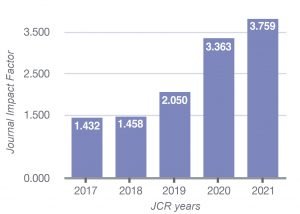
The increase in impact factor reflects the exacting standards met by the research the journal publishes. The impact factor is determined using the number of citations received in that year by articles published in the journal during the two preceding years and is calculated by Clarivate Analytics (formerly known as Thomson Reuters), a recognized authority for evaluating the usefulness of a journal.
BJBMS has joined the Q2 club! According to the Journal Citation Report published annually by Clarivate, BJBMS qualifies for Q2 based on the JCI. The Journal Citation Indicator (JCI) is the average Category Normalized Citation Impact of articles published by a journal over a recent three-year period.
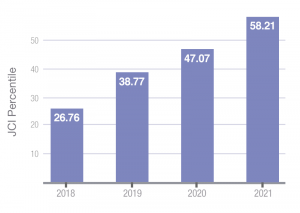
BJBMS’ CiteScore increased by 30%! CiteScore value is based on the number of citations to articles published by a journal over four years, divided by the number of the articles published in those same four years – and is another metric of journal quality.
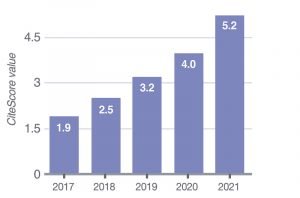
The Association of Basic Medical Sciences would like to wholeheartedly thank the Editorial Board, authors, and all the reviewers for their ongoing support, tremendous hard work, and dedication. Their contribution ensures that BJBMS continues to receive high-quality research material, enabling its community to advance medical research and education for the public benefit. BJBMS team will work hard in the future to become even better and to continue this rate of success.
What does BJBMS offer?
Broad readership and scope. The BJBMS reaches readers across a wide range of medical disciplines and sectors. The journal publishes basic and translational/clinical research submissions and reviews in all biomedical specialties, including Genetics and Molecular biology, Immunology, Microbiology, Pathology, Biochemistry, Pharmacology, Anatomy, Biomaterials, New and Emerging Research, New and Emerging Medical Entities, and others.
Open access. All research is available to the public for free. The BJBMS deposits published articles in PubMed Central, which satisfies the NIH Public Access Policy and other similar funding agency requirements.
Editorial Board. Renowned international experts in the journal’s Editorial Board, together with external peer-reviewers, select the best submissions for publication.
High visibility. Open Access: articles are freely available to readers immediately after publication; highly accessed online content: more than 200,000 visitors/month (70,000 at PubMed Central (May 2022); 50,000 at Journal’s website (May 2022); more than 80,000 at Web of Science, Scopus, Google Scholar, and others); newsletters: more than 20,000 registered users receive a newsletter tailored to their field of interest; social media: articles are promoted through various social media channels (Twitter, LinkedIn, Facebook); advanced online: all accepted articles are published Advanced online and Ahead of print on PubMed within 1 days of acceptance, with citable DOIs, to make the article accessible as fast as possible; print circulation: 300 copies of print issues are sent to major libraries, institutes, universities, conferences, and subscribers worldwide. Get the free sample copy here; BJBMS Viewpoints: Journal’s blog that promotes authors and their research by publishing plain language summaries for a wide audience and media, video author summaries, as well as commentaries, interviews, news, and stories related to science and research.
Indexing and abstracting. SCIE (Science Citation Index Expanded), Web of Science, Clarivate Analytics; JCR (Journal Citation Reports®), Clarivate Analytics; PubMed/MEDLINE; PubMed Central (PMC); SCOPUS; SJR (Scimago Journal and Country Rank); DOAJ; SCILIT; EBSCO; PROQUEST; Dimensions; Semantic Scholar; Google Scholar; EMBASE/Excerpta Medica; Europe PubMed Central; Medscape; ROAD; HINARI; CAS; X-MOL; CNKI; many libraries.
Timely publication. The 2021 peer review performance metrics:
- Average time from submission to initial decision: 2 days
- Average peer-review time and decision: 20 days
- Average time from acceptance to (advanced online) publication: 1 day
- Rejections without peer review: 40%
- Acceptance Rate: 20%
Who and what contributed to our success?
The best reviewers
As a means to promote the hard work and dedication invested “behind the scenes” in order to improve scientific publications, each month, BJBMS Editors select a reviewer who performed the best amongst all the reviewers in the current month. Selection is based on the quality, thoroughness, and timeliness of the review. It is a difficult task for our Editors, as they try not to underestimate the time and efforts of each of the reviewers who reviewed for the BJBMS in the current month. The best reviewers for the past year were:
- Dr. Asrul Abdul Wahab (July 2021)
- Dr. Kenneth R. Phelps (August 2021)
- Dr. Adrian Montano (September 2021)
- Dr. Ping Wu (October 2021)
- Dr. Emma Marczylo (November 2021)
- Dr. Kiril Trpkov (December 2021)
- Dr. Edin Medjedovic (January 2022)
- Dr. Wayne J.G. Hellstrom (February 2022)
- Dr. Diogo Goulart Correa (March 2022)
- Dr. Marek Hampl (April 2022)
- Dr. Damian Kołat (May 2022)
- Dr. Teodora Stankova (June 2022)
The most cited articles
- Targeted immunotherapy with a checkpoint inhibitor in combination with chemotherapy: A new clinical paradigm in the treatment of triple-negative breast cancer
- Pathogenesis of atherosclerosis in the tunica intima, media, and adventitia of coronary arteries: An updated review
- Cannabinoids in cancer treatment: Therapeutic potential and legislation
- SARS-CoV-2 infection of the nervous system: A review of the literature on neurological involvement in novel coronavirus disease-(COVID-19)
- Analysis of multidrug-resistant bacteria in 3223 patients with hospital-acquired infections (HAI) from a tertiary general hospital in China
Contributions by organizations
Top 5 organizations that have contributed the most papers to the journal in the most recent three-year period were
- UNIVERSITY OF MARIBOR
- UNIVERSITY OF LJUBLJANA
- MAYO CLINIC
- QATAR UNIVERSITY
- SAPIENZA UNIVERSITY ROME
Contributions by country
Top 5 countries that have contributed the most papers to the journal in the most recent three-year period.
- China
- Slovenia
- USA
- Turkey
- Bosnia and Herzegovina
Author’s Video summaries
Instead of the text-only Author Summary, a better way to present the research findings to the readers and followers is a Video Summary.
BJBMS has a YouTube channel where the author’s Video summaries reside. See them here.
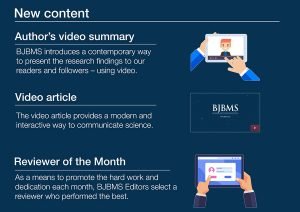
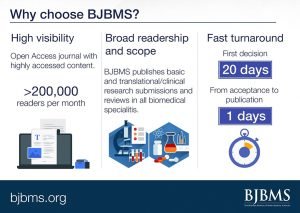
Read more about the BJBMS.
Leave a Reply